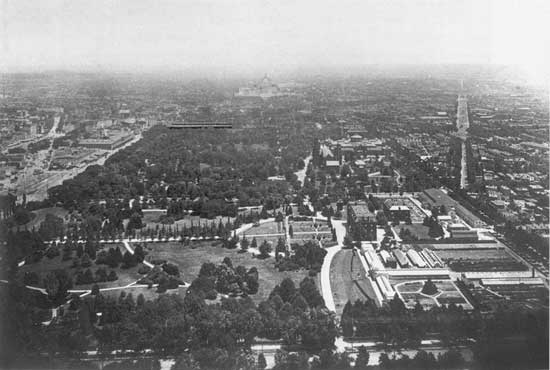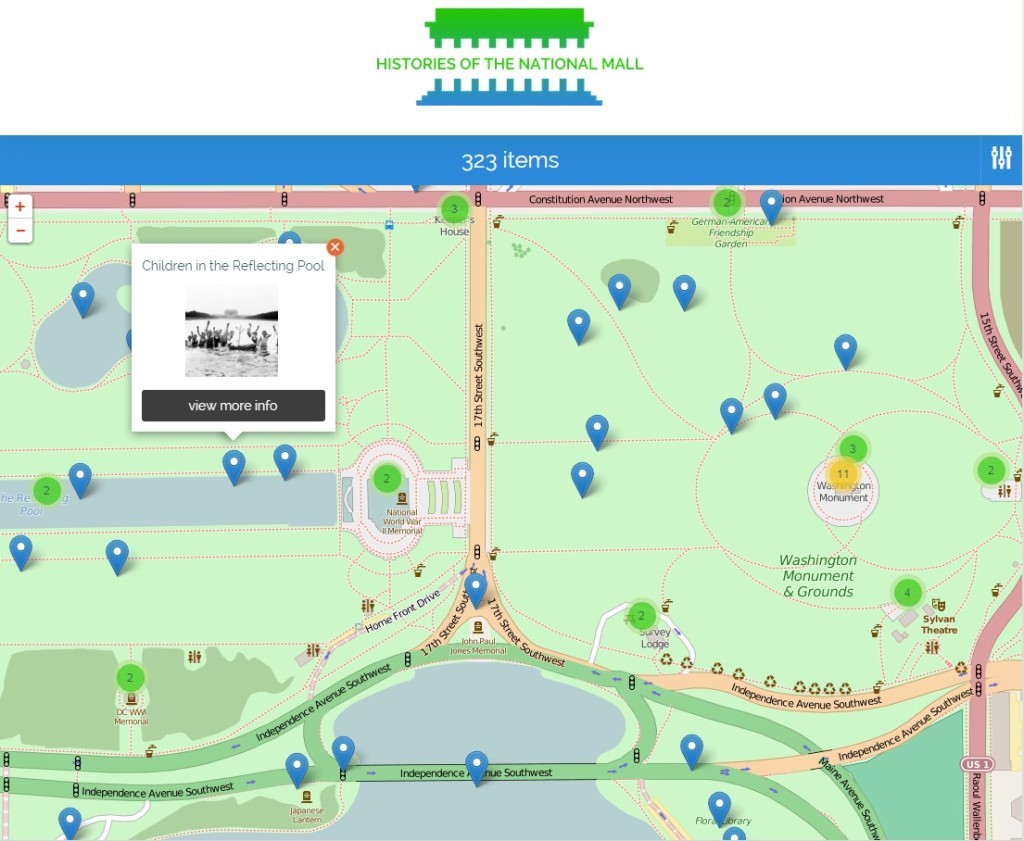Sharon M. Leon is director of public projects at the Roy Rosenzweig Center for History and New Media at George Mason University. Histories of the National Mall has been recently named the National Council on Public History’s Outstanding Public History Project for 2015.
Despite the aura of historical significance that accompanies the space, there is very little interpretation available on the Mall itself. Most visitors see what appears to be a finished product: a deliberately planned landscape with memorials, monuments, and museums symbolizing the history and values of the United States. But, in its earliest days, the Mall was a messy place bordered by lively neighborhoods where transportation arteries and commercial markets co-existed. Visitors, and many DC area residents, have no knowledge of the unregulated zone of muddy grounds, with vegetable gardens, grazing cattle, or the slave pens that existed before the completion of the Washington or Lincoln Memorials.
Perhaps you will be one of the nearly 25 million people who visit the National Mall in Washington, DC, each year for a family vacation or a conference. With the crowds you may find yourself wandering from monument to museum to government agency, only vaguely aware of the rich history of the space. Histories of the National Mall is a freely available place-based public history website developed with support of a grant from the National Endowment for the Humanities, and designed to let visitors to the Mall use the computing devices that they are already carrying in their pockets to dive into that rich history. Mallhistory.org is a mobile-first website, which means that it is accessible from any web browser on any phone, tablet, laptop, or desktop. We at the Rosenzweig Center attribute the project’s success to three concrete things that the project does well: it addresses an audience need; it delivers rich content in a form that is user-friendly; and it allows users to explore their own interests.
Our goal in creating the site was to offer visitors to the National Mall a way to encounter surprising and compelling stories and primary sources that together build a textured historical context for the space and the ways that it has changed over time as they explored this space itself. This was a tall order that required nearly five years of planning, research, and active development from a large collaborative team of scholars, designers, and web developers. Drawing on the extensive range of primary sources available at DC cultural heritage institutions, we assembled a rich documentary record of the many historical facets of the National Mall. Then, we added a layer of rigorous historical interpretation to those sources, synthesizing the most recent public history scholarship, raising provocative questions about the space, its role in national life, and the expressions of American ideals that have taken place there—questions that have engaged scholars for decades. Importantly, Histories of the National Mall uses the Mall to connect the development of Washington as a residential city with its role as the nation’s capital.
Unlike the work of writing journal articles or monographs, the success of this project hinged on translating those sources and historical scholarship into a form and voice that meets the needs of the public users accessing the material within the space of the Mall. Making the materials available was not sufficient. They had to be adapted to fit the mobile medium and the public user. Our decision to design for the mobile web, and not develop an app, was tied directly to our goal of reaching the largest percentage of the millions of annual visitors to the Mall. Histories of the National Mall is not constrained by the quickly evolving world of mobile application development protocols and is accessible on the widest range of mobile devices and to the broadest audience of visitors, all of whom can use the free WiFi available on the Mall and in the Smithsonian museums. This approach also makes the content more discoverable because the site is indexed by major search engines. Finally, the work of the project includes an energetic outreach campaign that makes use of print advertising and social media to ensure as many visitors as possible are aware of the site.
The result of this research and development was a website that allows users to engage in the self-guided exploration of over 440 items, including people, sites, past events, and primary sources, with 40 inquiry-based explorations. We created four different entry points that are place-based, thematic, chronological, and biographical, connecting the physical space and its development, together with the social, cultural, and political events that have transpired there.
- Maps offer a wayfaring guide to today’s Mall and eight historical maps that depict the Mall’s features and environment at different points in time. Historical events and sources appear as pins on the maps. Choosing a historical map layer then reveals to users events and sources from that time period located near them.
- Explorations are short episodes about the Mall’s history that begin with a question, such as: Were slaves bought and sold on the Mall? How have protests on the Mall changed over time? Why is there a lockkeeper’s house on the Mall? Each question is answered with historical sources from DC area libraries, archives, and museums. Users may browse by question or theme (including politics & protest; design & monuments; work & play; commerce & trade, and ghost Mall).
- Past Events offer users a chronology of significant Mall-related events, grouped in eras of roughly 30 years. Users may jump to time periods that interest them, or scroll chronologically from the 18th century to the present.
- People provide short biographies of individuals who shaped the Mall’s past and present. These elements highlight the contributions of lesser-known individuals whose impact would be impossible to find anywhere on the Mall itself.
Since the beta launch in March 2014, the site has demonstrated a steady increase in traffic, and the number of unique visitors rises each month. These signs point to the fact that Histories of the National Mall has struck the right balance between mobile-first design and engaging content and interpretation to create a digital public history project that will enrich the experience of visitors in years to come. More importantly, the site offers an example of the ways that careful work can translate historical scholarship into a form that reaches our publics where they are.
This post first appeared on AHA Today.
Tags: AHA Today Public History Urban History
Comment
Please read our commenting and letters policy before submitting.








